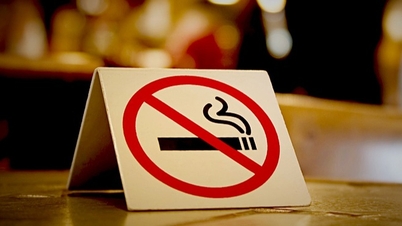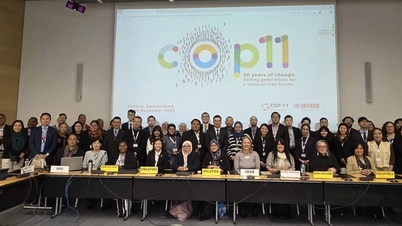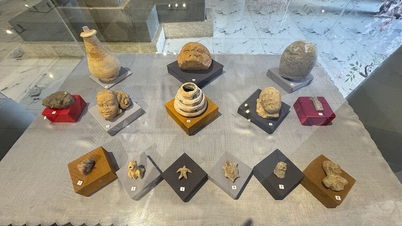This is the result of the study Monitoring PM2.5 fine dust concentration in indoor smoking-free food and entertainment establishments in 2025, conducted by the University of Public Health .

Associate Professor, Dr. Le Thi Thanh Huong, Vice Principal of the University of Public Health, shared the research results.
The data collection period was from June 23 to August 30 at 85 cafes, restaurants, bars, and karaoke bars that serve customers indoors in three cities: Hanoi , Bac Ninh, and Hoi An. The food and entertainment establishments in the study have different regulations on smoking areas. Each location is classified into one of three groups:
- Absolutely no smoking indoors (no smoking signs, no ashtrays);
- There is a separate area for DSA/DSR smokers (in the same space, there are tables that allow smoking and tables that do not allow smoking);
- Smoking is allowed throughout the house (ashtrays on most tables, no no smoking signs).
The team used an indoor air quality meter, placed in the place where customers usually sit, and measured continuously for about 60 minutes during peak hours. In addition, the researchers also recorded the number of smokers, the area of the shop, the type of service, etc. for analysis.
Cigarette smoke is one of the main sources of PM2.5 fine dust in closed spaces.
At a workshop sharing research results held in Hanoi on November 19, Associate Professor, Dr. Le Thi Thanh Huong, Vice Rector of the University of Public Health, said that this is the first study in Vietnam using high technology to accurately measure and evaluate the concentration of fine dust and the level of exposure to toxic substances from cigarettes.

Associate Professor Huong brought to the workshop a device to measure PM2.5 fine dust concentration to introduce to delegates.
According to Associate Professor Thanh Huong, cigarette smoke has long been proven to be harmful to both smokers and those who inhale secondhand smoke. The Law on Prevention and Control of Tobacco Harms has stipulated that many indoor public places must completely ban smoking on the premises.
However, in reality, some restaurants, cafes, bars, and karaoke bars still allow smoking indoors or arrange separate areas for smokers.
Cigarette smoke is one of the main sources of PM2.5 in enclosed spaces. When someone smokes in a bar, the PM2.5 level immediately spikes. This means that everyone in the space – even non-smokers – is exposed to cigarette smoke and particulate matter.
"The research team of the University of Public Health measured the concentration of fine dust PM2.5 - an important index reflecting the level of air pollution, including cigarette smoke - right at the shops that people still visit every day" - Associate Professor, Dr. Huong informed.
According to experts, PM2.5 fine dust concentration is an important indicator of the presence of secondhand smoke because cigarette smoke is one of the densest sources of PM2.5 emissions in the environment. The study also assessed the level of particle pollution and the level of exposure to toxic substances characteristic of cigarettes.

PM2.5 concentrations among three types of smoking bans at cafes and restaurants. Photo provided by the research team
Accordingly, the research results recorded that the concentration of fine dust PM2.5 is clearly different between the types of smoking regulations. Specifically, at indoor smoking-free establishments, the average PM2.5 concentration is about 19.83 µg/m³, lower than the WHO's 24-hour recommendation (25 µg/m³);
In places with separate smoking areas, PM2.5 concentrations increased to about 41.76 µg/m³ (This concentration was higher than in bars with no indoor smoking and was statistically significant).
At bars that allow smoking in all indoor areas, PM2.5 concentrations reached about 50.94 µg/m³, twice as high as the WHO's recommended level.
By service type, coffee shops have an average PM2.5 concentration of about 27µg/m³, restaurants 38µg/m³, karaoke 54µg/m³ and bars up to about 145µg/m³.

MSc. Dr. Phan Thi Hai - Deputy Director of Tobacco Harm Prevention Fund spoke.
Proposal to consider removing regulations on separate indoor smoking areas at food and entertainment establishments
When comparing the number of cigarettes burning in a restaurant with the PM2.5 concentration, the research team found a very close correlation: The more people smoke in a restaurant, the higher the PM2.5 index there is. This confirms that cigarette smoke is one of the main sources of indoor air pollution in food and entertainment establishments.
The research results help provide scientific , objective evidence on the level of exposure to secondhand smoke, and contribute to building arguments for recommendations to eliminate indoor smoking areas and promote smoke-free environments in public places.

Experts from the Tobacco Harm Prevention Fund speak.
From the measured results, the research team recommended considering removing the regulation of separate indoor smoking areas at food and entertainment establishments, because in reality it cannot prevent smoke and fine dust from spreading to other areas;
Strengthen inspection and supervision of the implementation of regulations on no smoking indoors; support localities and businesses in propagating to facility owners and people;
At the same time, continue to conduct research to measure indoor air quality in many provinces/cities to have a more complete view, as a basis for policy adjustments.

Ms. Doan Thi Thu Huyen, Vietnam Program Director, CTFK organization spoke.
MSc. Nguyen Huu Quy, Head of the Department of Health Education and Communication, Da Nang City Center for Disease Control, said that the scientific data from the study is a convincing theoretical and practical basis for provinces and cities to implement strong intervention activities and build a truly effective smoke-free environment.
At the same time, it is also an important basis to encourage business owners, especially tourism and service establishments, to voluntarily apply the 100% smoke-free model.
MSc. Bui The Thuc, Head of the Department of Health Education and Communication, Bac Ninh Province Center for Disease Control No. 2, said that in the past, to determine where there was frequent cigarette smoke, we could only use qualitative methods, which simply meant "seeing with the eyes, hearing with the ears and smelling with the nose".
"If the research of the University of Public Health is applied in practice, it will be a big step forward in managing smoke-free areas, helping localities better plan tobacco harm prevention plans, ensuring community health," said Mr. Thuc.

Mr. Bui The Thuc spoke.
According to the World Health Organization (WHO), globally, more than one-third of people are regularly exposed to second-hand smoke. Article 8 of the WHO FCTC recommends eliminating exposure to tobacco smoke in indoor workplaces, public transport, indoor public places and other public places.
In all types of food and entertainment service establishments in Vietnam, the law prohibits smoking indoors.
In that context, the study also serves as a scientific basis for assessing the implementation and effectiveness of smoke-free environments, providing scientific evidence for communication activities and improving gaps in policies regulating smoke-free areas.
Source: https://suckhoedoisong.vn/nong-do-bui-min-pm25-tang-gap-2-lan-khuyen-cao-cua-who-tai-noi-van-cho-hut-thuoc-trong-nha-169251120005201711.htm


![[Photo] President Luong Cuong receives President of the Senate of the Czech Republic Milos Vystrcil](/_next/image?url=https%3A%2F%2Fvphoto.vietnam.vn%2Fthumb%2F1200x675%2Fvietnam%2Fresource%2FIMAGE%2F2025%2F11%2F20%2F1763629737266_ndo_br_1-jpg.webp&w=3840&q=75)
![[Photo] Lam Dong: Panoramic view of Lien Khuong waterfall rolling like never before](/_next/image?url=https%3A%2F%2Fvphoto.vietnam.vn%2Fthumb%2F1200x675%2Fvietnam%2Fresource%2FIMAGE%2F2025%2F11%2F20%2F1763633331783_lk7-jpg.webp&w=3840&q=75)


![[Photo] National Assembly Chairman Tran Thanh Man holds talks with South Korean National Assembly Chairman Woo Won Shik](/_next/image?url=https%3A%2F%2Fvphoto.vietnam.vn%2Fthumb%2F1200x675%2Fvietnam%2Fresource%2FIMAGE%2F2025%2F11%2F20%2F1763629724919_hq-5175-jpg.webp&w=3840&q=75)









































































































Comment (0)